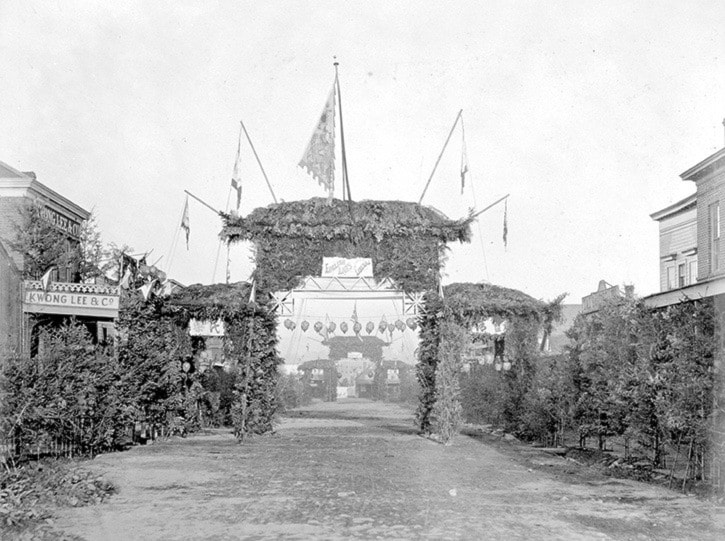Dr. Tzu-I Chung / Royal B.C. Museum
In the spring of 1858, news of gold in the Fraser Canyon transformed Fort Victoria from a quiet fur trade outpost of the Hudson’s Bay Company into a booming town.
Hop Kee & Co. of San Francisco played an instrumental role in the first wave of Chinese to Victoria.
On June 24, 1858, it commissioned Allan Lowe & Co. to ship 300 Chinese men and 50 tons of merchandise to Victoria at the cost of $3,500. Most men departed for the gold fields soon after arriving.
Throughout the summer of 1858 and 1859 Chinese continued to arrive from the United States; by 1859 clipper ships were bringing hundreds of Chinese immigrants directly from Hong Kong.
Initially, unlike Californians, British Columbians were tolerant of the Chinese. Few Caucasians perceived the Chinese as a threat to their wellbeing; some regarded them as useful or valuable members of the communities who shared the goal of making money, often providing useful services such as restaurants, laundries, and fresh vegetables and whose presence might lead to the growth of a profitable trans-Pacific trade.
When Victoria was incorporated as a city in 1862, 300 people, about six percent of the city’s population, were Chinese.
Since 1858, Victoria had served as the major port between Canada and Asia and had the second largest Chinese population in North America. After the Canadian Pacific Railway was completed in 1885, Vancouver was established as its western terminus, and economic activities gradually shifted to Vancouver.
A few Chinese, however, benefitted from the booming trans-Pacific trade and Victoria’s Chinatown also prospered, along with a network of subsidiaries and agencies in all the gold rush towns of B.C.
The trans-Pacific network enabled Chinese to contribute much to the building of British Columbia. In the 1860s and 1870s, besides mining, Chinese men also worked on many public projects such as erecting telegraph poles, constructing the 607-kilometre Cariboo Wagon Road, building trails, digging canals, and reclaiming wastelands.
Lee Chong, manager of Kwong Lee & Co., was one of the very few Chinese immigrants who was wealthy enough to have his family join him. On Feb. 29, 1860, his wife and two children arrived in Victoria; Mrs. Lee Chong became the first Chinese woman to settle in Victoria.
Lee Chong also represented the Chinese community before the government. On March 7, 1860, Lee Chong and two other Chinese merchants went to see Governor James Douglas after hearing a suggestion to impose a poll tax on Chinese immigrants. When Governor Arthur Kennedy arrived in Victoria in April 1864, Lee Chong, Tong Kee and Chang Tsoo called on him to express concern about the unfair treatment of the Chinese and the government’s plan to modify the colony’s free trade policy.
In the late 19th century, one of the main complaints against the Chinese presence was the perception that they were sojourners who contributed little to the local economy before moving on to another gold field or back to China. Yet, as the example of Lee Chong shows, for some the gold rush migration pattern of the Chinese paralleled that of Europeans’ settler communities along the Pacific Rim.
The pioneer merchants helped write a significantly transformative chapter in trans-Pacific and Chinese Canadian history and demonstrated that not all Chinese were labourers or sojourners. Many of these early migrants contributed to the building of British Columbia.
Gold Rush: El Dorado in B.C. opens at the Royal B.C. Museum on May 13.
•••
Dr. Tzu-I Chung is a curator of history at the Royal B.C. Museum, specializing in the multicultural and intercultural history of B.C.
